This article was co-authored by Mike Parra. Mike Parra is a Master Mechanic in Arizona. With over 20 years of mechanic experience, he has experience working with American, European, and other foreign makes and models. He is ASE (Automotive Service Excellence) certified and has an AA degree in Automotive Repair Technology.
wikiHow marks an article as reader-approved once it receives enough positive feedback. In this case, 92% of readers who voted found the article helpful, earning it our reader-approved status.
This article has been viewed 1,076,981 times.
You can quickly and easily fill up your car's tires using a home or gas station air pump. Make sure to keep a tire pressure gauge on hand for a more precise fill. Keeping your tires filled to the correct pressure will help protect against tire blowouts, which occur when there is a rapid drop in tire pressure. Proper tire inflation will also maximize your gas mileage and make for more efficient driving.
Steps
Gauging Pressure
-
1Buy a tire pressure gauge. Look for the tool at an auto-parts store – something like NAPA, AutoZone, Checker, Kragen, O'Reilly, or Canadian Tire. Pocket gauges are inexpensive and portable. Prices range from $5 for a basic gauge to more than $30 for one that is digital, has an air-release button, or even talks.[1] There are two types of pocket gauge: dial-type and pencil-type.
- The pencil type is long, slender, and metallic, about the size of a pencil. It contains a graduated sliding extension that is forced out of the sleeve by air pressure when attached to the tire stem.
- The dial type has a similar fitting to the pencil type, but it includes a graduated gauge and needle.
-
2Check the pressure in your tires. Find the small rubber or metal valve stem along the inside rim of your wheel, and unscrew it to reveal the air valve. Press the open end of the pressure gauge into the air valve. Hold it there, steadily and firmly, and listen for a light rushing sound as the gauge reads the pressure from the force of the air. After a few moments, pull the gauge away from the tire and read the pressure from the small screen on the side of the device.Advertisement
-
3Determine how much air should be in your tires. Car tire pressures usually range from 30-35 psi (pounds per square inch), although light trucks often require a higher pressure.[2] Some vehicles need the same amount of pressure in every tire, but others will have different values for front and rear tires. Tires naturally tend to deflate about 1 psi each month. You should check your tire pressures monthly at a minimum, since ambient temperature affects tire psi. This is a good way to catch a slow leak. It is a good idea to check your tires pressures when you fill up with gas. Rather than standing by the pump, grab your tire pressure gauge and check your tire pressure. Be sure to check the air pressure in your spare twice a year, otherwise it will also be flat when you need it.
- Consult your car's manual or your driver-side doorpost for the recommended tire pressures. The label will have a recommended tire psi or kpa (kilopascal) number.
- If your tire is outright flat, then it may have a leak. Try adding air to the tire and see if it holds air. If the tire holds air, drive on if for a short while and recheck the tire pressure. If the pressure drops, the tire has a slow leak and should be taken to a tire store to have the leak repaired. If you can hear air escaping while adding air, it is time to install the spare tire. If more than one tire has blown out, then you may need to call a tow truck.
Preparing to Pump
-
1Remove the valve stem caps. You'll want to screw these back on later, so set them to the side or put them into your pocket. Consider leaving each stem cap on its valve until you are about to pump that tire – this way, the caps will spend most of their time in the right place, and you won't have to worry so much about losing them.
-
2Find an air pump. Automatic air compressors are more expensive, but much faster. You can use a manual floor pump, like a bicycle pump, but it will take much longer and it'll be much more labor-intensive. You can buy your own air pump, or find a friend who owns one – but if not, most gas stations host a stand of coin-operated air and water pumps.
- If you use a bicycle pump, make sure that it is schrader-valve compatible. Consider asking someone to help you pump so that you don't need to do it all yourself. Car tires are much larger than bicycle tires!
- You can purchase an air pump that plugs into the car's 12v outlet at the auto parts store when you purchase a tire pressure gauge.
-
3Make sure that your tires are cold. This means that first thing in the morning or you've driven less than 2 miles (3.2 km) on them since they went flat. If you've driven more than a mile or two, your pressure-gauge readings will be inaccurate.
-
4Use the air pump at the nearest gas station. It's usually located on the outskirts of the gas station's parking lot – somewhere out of the way of the gas pumps. If you don't see it, ask the attendant. Pull your car alongside the air dispenser and find the coin slot. Pump prices range from a few cents to as much as a dollar (for a few minutes).
- Pull your car in close enough that the pump hose can reach all four tires. This is less important if you only intend to fill one or two tires.
- Check your tire pressure while filling up with fuel. Most gas stations that charge for air will waive your tire-pump fee if you've already bought gas. You may need to go inside and speak with and present the gas receipt to the station attendant.
Filling Your Tires
-
1Hook up the pump. If you are at a gas station, turn on the pump by feeding the machine the requisite amount of coins. You should hear a loud rumbling and humming noise when the pump is running. Stretch the air hose around to your closest tire (or to the tire in need of filling) and press the tip of the pump to the tip of the air valve. Hold it there, firmly and steadily, and listen to the rush of air as the pump fills the tire.
- If you hear a wild spraying of air, try to steady the pump. There's a good chance that the tip of the hose is not flush against the valve.
-
2Be patient. If your tires are low on pressure, it may take you several minutes of continuous pumping to fill each tire. If you've filled your tires within the past few months, and you're just topping them off, the process might last as little as 10-20 seconds. Consider using a hand pump for these small top-offs if you are wary of spending money on a full coin-operated machine.
-
3Check the pressure as you go, and adjust as needed. When you think that you've added enough air, pull the hose away and use your pressure gauge to read the pressure. Again, most tires should be 30-35 psi – but check the specifications for your car to be sure. Add air if the reading is lower than it should be, and release air if the reading is higher than it should be. When you've reached the proper pressure, you're done adding air to the tire.
- To release air from the tire, depress the center pin of the valve stem with a fingernail or a tool. You should hear a steady hiss as compressed air jets forth from the over-inflated tire. Release the air in small increments so as not to release too much air, checking the tire pressure often while lowering the tire pressure.
- Make sure to inflate your tires to the suggested pressure, even if they're only low by one or two psi units. It's estimated that for every 3 psi below the specified amount, you burn one percent more fuel. You may also suffer up to 10 percent more tire wear.[3]
-
4Replace the valve stem cap. When you're done adding air to each tire, make sure to replace the stem cap. It is not essential that you seal up the valve, but it will make your tire less likely to lose air. The valve should not release air unless anything depresses it – a twig, a finger, or any stray object.
-
5Repeat the process for each tire. If the hose won't reach, then feel free to move the car closer or turn it around. Keep in mind, however, that each pump session only runs for a limited time – so you'll need to be quick if you don't want to pay for another go!
Warnings
- Due to the abuse some gas station air compressors take, the gauges included on their compressor may be inaccurate. If possible, try to consult your own gauge.⧼thumbs_response⧽
- Be careful not to fill the tire with far more air than your car should have. Usually about 40 or more PSI on many vehicles is approaching exploding levels. To be safe, don't go more than 5 PSI over the recommended levels.⧼thumbs_response⧽
- Due to the limited time allowed at the air pump, consider over-filling each tire (as per the gauge on the air dispenser) to be safe. Once done, grab your own tire gauge, test each tire's pressure, and bleed a bit of air if necessary.⧼thumbs_response⧽
- Sometimes, the gauge is included at the end of the air dispenser hose and is made of metal with etched markings. This style can be hard to read at night. Bring your own gauge for reliability.⧼thumbs_response⧽
- Be careful to properly inflate your tires. Over-inflation can lead to increased tire wear in the center of the tire and affect handling and riding comfort. Under-inflation can lead to extra flex in the tire, causing them to overheat and blow out. This can cause a roll-over in vehicles with high center of gravity, such as SUVs. Under-inflation also increases tire wear and wastes energy (significantly lowers gas mileage). Note that the tires typically have a higher max pressure rating than the pressure posted on the vehicle. Do not go under the vehicle's posted pressure.⧼thumbs_response⧽
- It is wise to avoid leaning on top of the tire when filling it with air. Although the tire is not likely to pop at slightly higher than recommended pressure, you want to avoid being on top just in case to avoid injury.⧼thumbs_response⧽
- When using high-pressure air compressor (such as at a gas/petrol station) to fill air in a bicycle tire, add air in shorter increments to avoid over-inflating the tire and possibly popping the tube.⧼thumbs_response⧽
- It may be wise to keep necklaces and any hanging jewelry or items away while working on tires (and any car parts usually).⧼thumbs_response⧽
Things You'll Need
- Tire pressure gauge (dial-type models are the most accurate).
- Air pump/compressor.
References
About This Article
To fill air in a car's tires, pull the car into a gas station that has an air pump and park next to the air dispenser. Use a tire gauge to check the air pressure, then consult your car's manual for the recommended pressure -- standard car tires usually range from 30-35 psi. Insert coins into the dispenser and stretch the air hose around to the tire. Unscrew the valve stem cap, then press the tip of the pump to the tip of the air valve. Hold the hose firmly as you inflate the tire, use the gauge to check the pressure as you go, and adjust as needed. To learn more from our Mechanic co-author, such as when the right time of day to inflate your car's tires, keep reading!
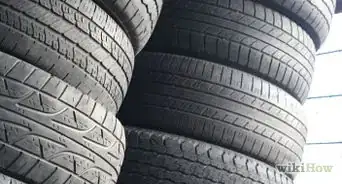
-Step-9-Version-2.webp)


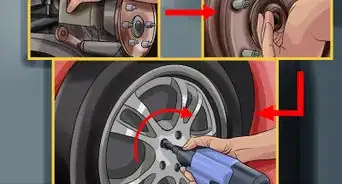

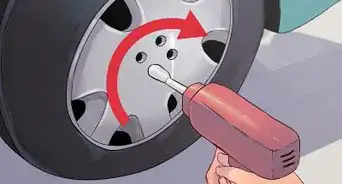

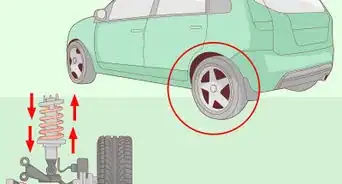










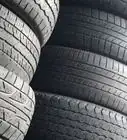
-Step-9-Version-2.webp)



































